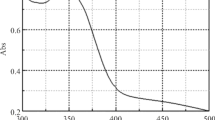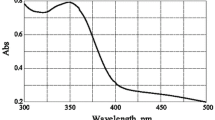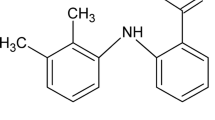Abstract
A series of studies was previously devoted to the dependence of the bioavailability of various tetracyclines on their coordination with calcium and magnesium ions. Several clinical investigations have also shown zinc to interfere with the gastrointestinal absorption of the drug in humans. On the other hand, the administration of tetracycline to rats was reported to result in the increase of the elimination rate of zinc, which could orginate in zinc-tetracycline interactions in blood plasma.
Formation constants for zinc complexes with tetracycline, oxytetracycline, doxycycline, minocycline, chlortetracycline and demethylchlortetracycline were thus determined at 37°C in NaCl 0.15 mol.dm−3 aqueous medium.
Computer simulations were then carried out to investigate the drug influence on the distribution of the low-molecular-weight fraction of zinc in human blood plasma. Zinc-tetracycline interactions in the gastrointestinal fluid were also simulated, using clinical data relative to fasting subjects as taken from the literature.
No significant effect can be expected from tetracyclines on the distribution of zinc in plasma at the usual therapeutic levels. However, zinc-tetracycline interactions have been found to be determining factors for the bioavailabilities of the metal as well as of the antibiotic in the gastro-intestinal fluid.
Similar content being viewed by others
References
D.R. Williams,Biofluid speciation models correlated with pharmaceutical activity, Proc. Sum. Conf. Comp. Simul., Boston Ms2, 792–797 (1984).
D.D. Perrin andH. Stünzi, Metal ions and Chelating agents in antiviral chemotherapy. InMetal Ions in Biological Systems, vol. 14, pp. 207–241 (Ed.H. Sigel). Marcel Dekker Inc., New York 1982.
P.M. May andR.A. Bulman, The present status of chelating agents in Medicine. InProgress in Medicinal Chemistry, vol. 20, pp. 225–336 (Ed.G.P. Ellis andG.B. West). Elsevier Science Publishers, New York 1983.
A. Cole, P.M. May andD.R. Williams,Metal binding by pharmaceuticals. Part 1. Cu(II) and Zn(II) interactions following ethambutol administration, Agents and Actions11, 296–305 (1981).
Z.X. Huang, P.M. May, K.M. Quinlan, D.R. Williams andA.M. Creighton,Metal binding by pharmaceuticals. Part 2. Interactions of Ca(II), Cu(II), Fe(II), Mg(II), Mn(II) and Zn(II) with the intracellular hydrolysis products of the antitumour agent ICFR 159 and its inactive homologue ICRF 192, Agents and Actions12, 536–542 (1982).
A. Cole, P.M. May andD.R. Williams,Metal binding by pharmaceuticals. Part 3. Cu(II) and Zn(II) interactions with isoniazid, Agents and Actions13, 91–97 (1983).
H. Al-Falahi, P.M. May, A.M. Roe, R.A. Slater, W.J. Trott andD.R. Williams,Metal binding by pharmaceuticals. Part 4. A Comparative investigation of the interaction of metal ions with hydralazine, prizidilol and related compounds, Agents and Actions14, 113–120 (1984).
A. Cole, J. Goodfield, D.R. Williams andJ.M. Midgley,The complexation of transition series metal ions by nalidixic acid, Inorg. Chim. Acta92, 91–97 (1984).
J.R.J. Sorenson, Copper complexes as the active metabolites of antiinflammatory agents. InInflammatory Diseases and Copper, pp. 289–301 (Ed.J.R.J. Sorenson). The Humana Press Inc., Clifton, New Jersey 1982.
D.R. Williams andB.W. Halstead,Chelating Agents in Medicine, J. toxicol. Clin. Toxicol.19 (10), 1081–1115 (1982–83).
F. Akrivos, M.J. Blais, J. Hoffelt andG. Berthon,An assessment of the physiological significance of cimetidine interactions with copper and zinc in biofluids as based on the computer-simulated distribution of the involved complexes at therapeutic levels of the drug, Agents and Actions,15, 649–659 (1984).
P.M. May, P.W. Linder andD.R. Williams,Computer simulation of metal-ion equilibria in biofluids: models for the low-molecular weight complex distribution of calcium (II), magnesium (II), manganese (II), iron (III), copper (II), zinc (II) and lead (II) ions in human blood plasma, J. Chem. Soc. Dalton, 588–595 (1977).
G. Berthon, P.M. May andD.R. Williams,Computer simulation of metal-ion equilibria in biofluids. Part 2. Formation constants for zinc (II) — citrate — cysteinate binary and ternary complexes and improved models of low-molecular-weight zinc species in blood plasma, J. Chem. Soc. Dalton, 1433–1438 (1978).
G. Berthon, C. Matuchansky andP. M. May,Computer simulation of metal-ion equilibria in biofluids. Part 3. Trace metal supplementation in total parenteral nutrition, J. Inorg. Biochem.13, 63–73 (1980).
G. Berthon, M. Piktas andM.J. Blais,Trace metal requirements in total parenteral nutrition. Part 6. A quantitative study of the copper (II) — histidine ternary complexes with leucine, glutamic acid, methionine, tryptophan and alanine, and final evaluation of the daily doses of copper and zinc specific to a nutritive mixture of a given composition, Inorg. Chim. Acta93, 117–130 (1984).
P.M. May, G.L. Smith andD.R. Williams,Computer calculation of zinc (II) complex distribution in milk, J. Nutr.112, 1990–1993 (1982).
M. Brion, G. Berthon andJ.B. Fourtillan,Metal ion-tetracycline interactions in biological fluids. Potentiometric study of calcium complexes with tetracycline, oxytetracycline, doxycycline and minocycline and simulation of their distributions under physiological conditions. Inorg, Chim. Acta55, 47–56 (1981).
G. Berthon, M. Brion andL. Lambs,Metal iontetracycline interactions in biological fluids. Part 2. Potentiometric study of magnesium complexes with tetracycline oxytetracycline, doxycycline and minocycline and discussion of their possible influence on the bioavailability of these antibiotics in blood plasma, J. Inorg. Biochem.19, 1–18 (1983).
L. Lambs, M. Brion andG. Berthon,Metal,iontetracycline interactions in biological fluids. Part 3. Formation of mixed-metal ternary complexes of tetracycline, oxytetracycline, doxycyline and minocycline with calcium and magnesium, and their involvement in the bioavailability of these antibiotics in blood plasma, Agents and Actions14, 743–750 (1984).
L. Lambs, M. Brion andG. Berthon,Metal iontetracycline interactions in biological fluids. Part 4. Potential influence of Ca 2+ and Mg 2+ ions on the bio-availability of chlortetracycline and demethylchlortetracycline, as expected from their computer-simulated distributions in blood plasma, Inorg. Chim. Acta106, 151–158 (1985).
M. Schach von Wittenau andR. Yeary,The excretion and distribution in body fluids of tetracyclines after intravenous administration to dogs. J. Pharmacol. Exp. Ther.140, 258–266 (1963).
A. Albert,Avidity of terramycin and aureomycin for metallic cations, Nature172, 201 (1953).
A. Albert andC.W. Rees,Avidity of the tetracyclines for the cations of metals, Nature177, 433–434 (1956).
P. Mikelens andW. Levinson,Nucleic acid binding by tetracycline metal ion complexes, Bioinorg. Chem.9, 421–429 (1978).
M. Saiki andF.W. Lima,Determination of the stability constants for the complexes or rare earth elements and tetracycline, J. Radioanal. Chem.36, 435–450 (1977).
T.F. Chin andJ.L. Lach,Drug diffusion and bioavailability: tetracycline metallic chelation, Am. J. Hosp. Pharm.32, 625–629 (1975).
J.T. Doluisio andA.N. Martin,Metal complexation of the tetracycline hydrochlorides, J. Med. Chem.6, 16–20 (1963).
L.A. Mitscher, A.C. Bonacci, B. Slater-Eng, A.K. Hacker andT.D. Sokoloski,Interactions of various tetracyclines with metallic cations in aqueous solution as measured by circular dichroism, Antimicr. Ag. Chem. 111–115 (1969).
R.K. Mapp andT.J. McCarthy,The effect of zinc sulphate and bicitropeptide on tetracycline absorption, S. Afr. Med. J.50, 1829–1830 (1976).
K.E. Andersson, L. Bratt, H. Dencker, C. Kamme andE. Lanner,Inhibition of tetracycline absorption by zinc, Europ. J. Clin. Pharmacol.10, 59–62 (1976).
O. Penttilä, H. Hurme andP.J. Neuvonen,Effect of zinc sulphate on the absorption of tetracycline and doxycycline in man, Europ. J. Clin. Pharmacol.9, 131–134 (1975).
J.L. Colaizzi andP.R. Klink,pH-partition behaviour of tetracyclines, J. Pharm. Sci.58, 1184–1189 (1969).
U.S. Food andNutrition Board,Recommended Dietary Allowances, 8th ed. Natl. Acad. Sci., Washington 1974.
K. Weismann, L. Knudsen andH. Høyer,Effects of tetracycline on the absorption of 65 Zn in rats, Arch. Dermatol. Res.263, 135–138 (1978).
A.S. Prasad andD. Oberleas,Zinc in human serum: evidence for an amino acid-bound fraction, J. Lab. & Clin. Med.72, 1006 (1968).
E.L. Giroux andR.I. Henkin,Competition for zinc among serum albumin and amino acids, Biochim. Biophys. Acta273, 64–72 (1972).
G. Berthon,Total parenteral nutrition (TPN) as a cause of depletion of trace metal ions. Computer-based interpretation and treatment, Inorg. Chim. Acta79, 46–48 (1983).
L.A. Mitscher, A.C. Bonacci andT.D. Sokoloski,Circular dichroism and solution conformation of the tetracycline antibiotics, Antimicr. Ag. Chem. 78–86 (1968).
L.A. Mitscher, B. Slater-Eng andT.D. Sokoloski,Circular dichroism measurements of the tetracyclines IV. 5-OH derivatives, Antimicr. Ag. Chem.2, 66–72 (1972).
M.E. Dockter andJ.A. Magnuson,Characterization of the active transport of chlortetracycline in staphylococcus aureus by a fluorescence technique, J. Supramol. Struct.2, 32–44 (1974).
F.J.C. Rossotti andH. Rossotti,Potentiometric titrations using Gran plots, J. Chem. Educ.42, 375–378 (1965).
M. Brion,Simulation quantitative de l'influence de la complexation du zinc et du cuivre avec les tétracyclines sur la biodisponibilité de ces réactifs dans le plasma sanguin et le fluide gastrointestinal, Thèse de 3ème Cycle no 947, Poitiers, Décembre 1983.
M.J. Blais andG. Berthon,A new contribution to the determination of the complex equilibria of oxidised glutathione with proton and copper (II) in aqueous solution, J. Chem. soc. Dalton 1803–1808 (1982).
A. Sabatini, A. Vacca andP. Gans,Miniquad. A General computer programme for the computation of formation constants from potentiometric data, Talanta21, 53–77 (1974).
A.M. Corrie, G.K.R. Makar, M.L.D. Touche andD.R. Williams,Thermodynamic considerations in coordination: Part XX. A computerised approach as an alternative to graphical normalised curve fitting as a means of detecting oligonuclear complexes in metal ion-ligand solutions and its application to the zinc (II)-, lead (II)-, and proton-glycine peptide systems, J. Chem. Soc. Dalton, 105–110 (1975).
L.J. Leeson, J.E. Kruger andR.A. Nash,Concerning the structural assignment of the second and third acidity constants of the tetracycline antibiotics, Tetrahedron Lett.18, 1155–1160 (1963).
P.M. May, P.W. Linder andD.R. Williams,Ambivalent effect of protein binding on computed distributions of metal ions complexes by ligands in blood plasma, Experientia32, 1492–1493 (1976).
P.J. Neuvonen, P.J. Pentikainen andG. Gothoni,Inhibition of iron absorption by tetracycline. Br. J. Clin. Pharmacol.2, 94–96 (1975).
S.A. Khalil, N.A. Daabis, V.F. Naggar andM. Wafik,Effect of magnesium trisilicate and citric acid on the bioavailability of tetracycline in man, Pharmazie32, 519–522 (1977).
P.F. D'Arcy, H.A. Muhyiddin andJ. McElnay,An in vitro model of drug-metal ion interactions in the gut, J. Pharm. Pharmacol.28 Supp. 33P (1976).
P.J. Neuvonen andH. Turakka,Inhibitory effect of various iron salts on the absorption of tetracycline in man, Europ. J. Clin. Pharmacol.7, 357–360 (1974).
K.E. Andersson, L. Bratt, H. Dencker andE. Lanner,Some aspects of the intestinal absorption of zinc in man, Europ. J. Clin. Pharmacol.9, 423–428 (1976).
G. Berthon, unpublished programme.
A.M. Fiabane andD.R. Williams,The principles of bio-inorganic chemistry, The Chemical Society, London, pp. 65 (1977).
Author information
Authors and Affiliations
Rights and permissions
About this article
Cite this article
Brion, M., Lambs, L. & Berthon, G. Metal ion-tetracycline interactions in biological fluids. Part 5. Formation of zinc complexes with tetracycline and some of its derivatives and assessment of their biological significance. Agents and Actions 17, 229–242 (1985). https://doi.org/10.1007/BF01966597
Received:
Issue Date:
DOI: https://doi.org/10.1007/BF01966597




